| S1060 |
Olaparib (AZD2281)
|
Olaparib (AZD2281, KU0059436) is a selective inhibitor of PARP1/2 with IC50 of 5 nM/1 nM in cell-free assays, 300-times less effective against tankyrase-1. It induces significant autophagy that is associated with mitophagy in cells with BRCA mutations.
|
-
Cell, 2025, 188(18):5081-5099.e27
-
Cancer Cell, 2025, 43(8):1530-1548.e9
-
Cancer Cell, 2025, 43(4):776-796.e14
|
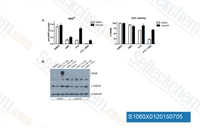
|
| S1180 |
XAV-939
|
XAV-939 (NVP-XAV939) selectively inhibits Wnt/β-catenin-mediated transcription through tankyrase1/2 inhibition with IC50 of 11 nM/4 nM in cell-free assays, regulates axin levels and does not affect CRE, NF-κB or TGF-β.
|
-
Nat Biotechnol, 2025, 10.1038/s41587-025-02649-1
-
Nat Cell Biol, 2025, NONE
-
Nat Cell Biol, 2025, 27(8):1240-1255
|
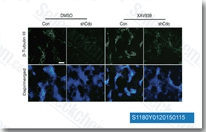
|
| S1004 |
Veliparib (ABT-888)
|
Veliparib (ABT-888, NSC 737664) is a potent inhibitor of PARP1 and PARP2 with Ki of 5.2 nM and 2.9 nM in cell-free assays, respectively. This compound is inactive to SIRT2 and increases autophagy and apoptosis. Phase 3.
|
-
Nat Commun, 2025, 16(1):8476
-
Nat Commun, 2025, 16(1):1026
-
J Exp Med, 2025, 222(5)e20241184
|
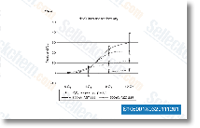
|
| S7048 |
Talazoparib (BMN-673)
|
Talazoparib (BMN 673, LT-673) is a novel PARP inhibitor with IC50 of 0.57 nM for PARP1 in a cell-free assay. It is also a potent inhibitor of PARP-2, but does not inhibit PARG and is highly sensitive to PTEN mutation. Phase 3.
|
-
Mol Cancer, 2025, 24(1):217
-
Nat Commun, 2025, 16(1):8476
-
Nat Commun, 2025, 16(1):6972
|
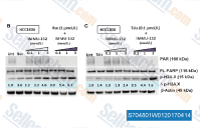
|
| S1098 |
Rucaparib phosphate
|
Rucaparib phosphate is an inhibitor of PARP with Ki of 1.4 nM for PARP1 in a cell-free assay, also showing binding affinity to eight other PARP domains. Phase 3.
|
-
Mol Cell, 2025, S1097-2765(25)00098-X
-
Cells, 2025, 14(14)1049
-
Cancer Res Commun, 2025, 10.1158/2767-9764.CRC-24-0515
|
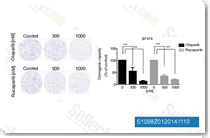
|
| S2741 |
Niraparib (MK-4827)
|
Niraparib (MK-4827) is a selective inhibitor of PARP1/2 with IC50 of 3.8 nM/2.1 nM, with great activity in cancer cells with mutant BRCA-1 and BRCA-2. It is >330-fold selective against PARP3, V-PARP and Tank1. This compound can form PARP–DNA complexes resulting in DNA damage, apoptosis, and cell death. Phase 3.
|
-
Nat Commun, 2025, 16(1):4239
-
Neuro Oncol, 2025, noaf061
-
Nucleic Acids Res, 2025, 53(4)gkaf086
|
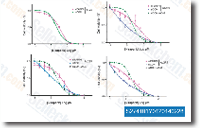
|
| S7300 |
PJ34 HCl
|
PJ34 HCl is the hydrochloride salt of PJ34, which is a PARP inhibitor with EC50 of 20 nM and is equally potent to PARP1/2.
|
-
Cell Death Differ, 2025, 10.1038/s41418-025-01457-z
-
J Neuroinflammation, 2024, 21(1):235
-
Nat Commun, 2023, 14(1):7161
|
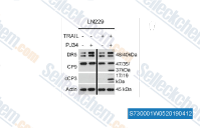
|
| S4948 |
Rucaparib (AG014699)
|
Rucaparib is an inhibitor of PARP with Ki of 1.4 nM for PARP1 in a cell-free assay, also showing binding affinity to eight other PARP domains.
|
-
Cancer Res, 2025, 10.1158/0008-5472.CAN-24-2938
-
Cancer Lett, 2025, 613:217505
-
Stem Cell Res Ther, 2025, 16(1):548
|
|
| S7625 |
Niraparib tosylate
|
Niraparib tosylate is a selective inhibitor of PARP1/PARP2 with IC50 of 3.8 nM/2.1 nM. Niraparib increases formation of PARP-DNA complexes resulting in DNA damage, apoptosis, and cell death.
|
-
Cancer Res Commun, 2025, 10.1158/2767-9764.CRC-24-0515
-
Nat Commun, 2024, 15(1):9463
-
Nat Commun, 2024, 15(1):1041
|
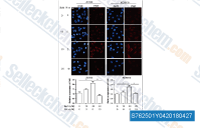
|
| S2178 |
AG-14361
|
AG14361 is a potent inhibitor of PARP1 with Ki of <5 nM in a cell-free assay. It is at least 1000-fold more potent than the benzamides.
|
-
Cell Rep, 2025, 44(4):115457
-
PLoS One, 2025, 20(3):e0318267
-
Nat Commun, 2024, 15(1):1041
|
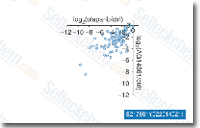
|
| S1087 |
Iniparib (BSI-201)
|
Iniparib (BSI-201, NSC-746045, IND-71677) is a PARP1 inhibitor with demonstrated effectiveness in triple-negative breast cancer (TNBC). Phase 3.
|
-
Cancer Res, 2025, 10.1158/0008-5472.CAN-24-2938
-
Nat Commun, 2024, 15(1):10347
-
Nat Commun, 2021, 12(1):736
|

|
| S5195 |
Rucaparib Camsylate
|
Rucaparib (Rubraca, AG014699, PF01367338) Camsylate is an inhibitor of PARP with Ki of 1.4 nM for PARP1 in a cell-free assay, also showing binding affinity to eight other PARP domains.
|
-
Cells, 2024, 13(16)1348
-
Adv Sci (Weinh), 2022, 9(30):e2201210
-
Cell Death Dis, 2022, 13(6):558
|
|
| S2197 |
A-966492
|
A-966492 is a novel and potent inhibitor of PARP1 and PARP2 with Ki of 1 nM and 1.5 nM, respectively.
|
-
Nat Commun, 2021, 12(1):736
-
Front Immunol, 2021, 12:712021
-
Front Immunol, 2021, 12:712021
|
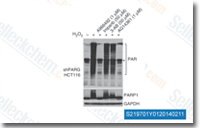
|
| S7239 |
G007-LK
|
G007-LK is a potent and selective tankyrase inhibitor with IC50 of 46 nM and 25 nM for TNKS1/2, respectively.
|
-
EBioMedicine, 2024, 103:105129
-
NPJ Precis Oncol, 2024, 8(1):264
-
bioRxiv, 2024, 2024.02.02.578667
|
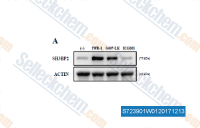
|
| S8038 |
UPF 1069
|
UPF 1069 is a selective PARP2 inhibitor with IC50 of 0.3 μM. It is ~27-fold selective against PARP1.
|
-
Autophagy, 2025, 1-17.
-
Cancer Lett, 2025, 613:217505
-
Cell Rep, 2023, 42(9):113113
|
|
| S7029 |
AZD2461
|
AZD2461 is a novel PARP inhibitor with low affinity for Pgp. Phase 1.
|
-
Nat Commun, 2021, 12(1):736
-
Cell Chem Biol, 2021, S2451-9456(21)00058-1
-
Dev Cell, 2020, 53(2):240-252.e7
|
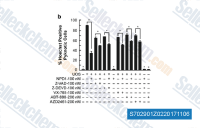
|
| S8592 |
Pamiparib
|
Pamiparib is a potent and selective inhibitor of PARP1 and PARP2 with IC50 values of 0.83 and 0.11 nM, respectively in biochemical assays. It shows high selectivity over other PARP enzymes.
|
-
United Eur Gastroent, 2025, 13(7):1328-1342
-
Cell Death Discov, 2024, 10(1):74
-
Cells, 2024, 13(16)1348
|
|
| S1132 |
3-Aminobenzamide
|
3-Aminobenzamide (3-ABA , 3-Amino Benzamide, 3-AB) is a potent inhibitor of Poly(ADP-ribose)polymerase (PARP) and inhibits cell apoptosis after SCI (Spinal Cord Injury) in caspase-independent way.
|
-
J Biol Chem, 2024, S0021-9258(24)02608-5
-
Int J Mol Sci, 2023, 24(2)1667
-
Psychopharmacology (Berl), 2022, 10.1007/s00213-022-06188-4
|
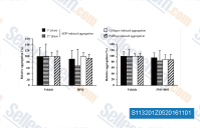
|
| S7438 |
ME0328
|
ME0328 is a potent and selective PARP inhibitor with IC50 of 0.89 μM for PARP3, about 7-fold selectivity over PARP1.
|
-
iScience, 2025, 28(4):112267
-
Mol Med, 2025, 31(1):216
-
Biomed Pharmacother, 2018, 97:115-119
|
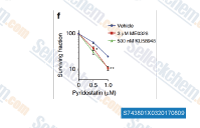
|
| S8363 |
NMS-P118
|
NMS-P118 is a potent, orally available, and highly selective PARP-1 inhibitor endowed with excellent ADME and pharmacokinetic profiles, showing 150-fold selectivity for PARP-1 over PARP-2 (Kd 0.009 μM vs 1.39 μM, respectively).
|
-
Cancer Lett, 2025, 613:217505
-
Res Sq, 2023, rs.3.rs-2688694
-
Res Sq, 2023, rs.3.rs-2688694
|
|
| S8419 |
Stenoparib (E7449)
|
Stenoparib (E7449, 2X-121, MGI25036) is an orally bioavailable, brain penetrable, small molecule dual inhibitor of PARP1/2 and also inhibits PARP5a/5b, otherwise known as tankyrase1 and 2 (TNKS1/2), important regulators of canonical Wnt/β-catenin signaling. It has IC50 values of 1.0 and 1.2 nM for PARP1 and 2, respectively.
|
-
Cancer Lett, 2025, 613:217505
-
Br J Pharmacol, 2024, 10.1111/bph.17305
-
Cell Death Discov, 2024, 10(1):74
|
|
| S7238 |
NVP-TNKS656
|
NVP-TNKS656 is a highly potent, selective, and orally active tankyrase inhibitor with IC50 of 6 nM for TNKS2, > 300-fold selectivity against PARP1 and PARP2.
|
-
Nat Commun, 2025, 16(1):4945
-
Dev Cell, 2025, S1534-5807(25)00496-4
-
Cell, 2024, 187(14):3671-3689.e23
|
|
| S7490 |
WIKI4
|
WIKI4 is a novel Tankyrase inhibitor with IC50 of 15 nM for TNKS2, and leads to inhibition of Wnt/beta-catenin signaling.
|
-
Sci Rep, 2022, 12(1):7
-
Carcinogenesis, 2020, 41(7):993-1004
-
Nat Commun, 2019, 10(1):4363
|
|
| S4715 |
Benzamide
|
Benzamide, a derivative of benzoic acid, is an inhibitor of poly(ADP-ribose) polymerase with an IC50 of 3.3 μM.
|
-
Int J Mol Sci, 2019, 20(21)
-
Mol Pharmacol, 2019, 96(4):419-429
-
Acta Neuropathol Commun, 2014, 2:57
|
|
| S8370 |
BGP-15 2HCl
|
BGP-15, is a nicotinic amidoxime derivative with PARP inhibitory activity. It has been demonstrated that BGP-15 protects against ischemia-reperfusion injury.
|
-
Part Fibre Toxicol, 2023, 20(1):28
-
Part Fibre Toxicol, 2023, 20(1):28
-
Respir Res, 2023, 24(1):319
|
|
| S7730 |
NU1025
|
NU1025 (NSC 696807) is a potent PARP inhibitor with IC50 of 400 nM.
|
-
J Natl Cancer Cent, 2024, 4(3):263-279
-
J Clin Med, 2020, 30;9(4)
-
Med Sci Monit, 2019, 25:2886-2895
|
|
| S5967 |
Berberine chloride hydrate
|
Berberine (Natural Yellow 18) chloride hydrate is a quaternary ammonium salt from the group of isoquinoline alkaloids. Berberine activates caspase 3 and caspase 8, cleavage of poly ADP-ribose polymerase (PARP) and the release of cytochrome c. Berberine chloride decreases the expression of c-IAP1, Bcl-2 and Bcl-XL. Berberine chloride induces apoptosis with sustained phosphorylation of JNK and p38 MAPK, as well as generation of the ROS. Berberine chloride is a dual topoisomerase I and II inhibitor. Berberine chloride is also a potential autophagy modulator.
|
-
Front Biosci (Landmark Ed), 2022, 27(8):242
-
Front Pharmacol, 2021, 12:632201
|
|
| S6745 |
JW55
|
JW55 is a potent and selective inhibitor of the canonical Wnt pathway that functions via inhibition of the PARP domain of tankyrase 1 and tankyrase 2 (TNKS1/2).
|
-
Cell Discov, 2024, 10(1):39
-
Oncotarget, 2021, 12(7):674-685
-
Chin J Integr Med, 2021, 10.1007/s11655-021-3282-0
|
|
| S0519 |
BYK204165
|
BYK204165 is a potent and selective inhibitor of the poly(ADP-ribose) polymerase (PARP). This compound inhibits cell-free recombinant human PARP-1 (hPARP-1) with pIC50 of 7.35 and pKi of 7.05 and murine PARP-2 (mPARP-2) with pIC50 of 5.38, respectively.
|
-
Sci Transl Med, 2021, 13(592)eabc7211
|
|
| S9712 |
Fluzoparib (SHR-3162)
|
Fluzoparib (SHR3162, HS10160) is a potent Poly (ADP-ribose) polymerase (PARP) inhibitor that shows anti-tumor activity, with an IC50 of 1.46±0.72 nM for PARP1.
|
-
iScience, 2024, 27(10):110862
-
Biochemistry, 2023, 62(16):2382-2390
|
|
| S4710 |
Picolinamide
|
Picolinamide (2-Pyridinecarboxamide, Picolinoylamide, 2-Carbamoylpyridine) is found to be a strong inhibitor of poly (ADP-ribose) synthetase of nuclei from rat pancreatic islet cells.
|
-
Neural Regen Res, 2023, 18(10):2252-2259
-
Neural Regen Res, 2023, 18(10):2252-2259
|
|
| E1425 |
Nesuparib
|
Nesuparib (JPI-547, NOV140201) is a potential inhibitor of both PARP and tankyrases, with IC50 of 0.005 μM, 0.001 μM, 0.002 μM, and ND for TNKS1, TNKS2, PARP1, and PARP2, respectively. This compound exhibits anti-tumor activity in BRCA-deficient xenograft models.
|
|
|
| S6899 |
Licochalcone D
|
Licochalcone D (Lico D, LCD, LD), a flavonoid isolated from a Chinese medicinal plant Glycyrrhiza inflata, has antioxidant, anti-inflammatory and anti-cancer properties. This compound inhibits phosphorylation of NF-κB p65 in LPS signaling pathway. It inhibits JAK2, EGFR and Met (c-Met) activities and induces ROS-dependent apoptosis. This chemical also induces caspases activation and poly (ADP-ribose) polymerase (PARP) cleavage.
|
|
|
| S6977 |
DR2313
|
DR2313 is a potent, selective, competitive and brain-penetrant inhibitor of poly(ADP-ribose) polymerase (PARP), with IC50s of 0.20 μM and 0.24 μM for PARP-1 and PARP-2, respectively.
|
|
|
| S6739 |
MN 64
|
MN-64 is a potent inhibitor of TNKS1 and TNKS2 with IC50 value of 6 and 72 nM, respectively.
|
|
|
| S0913 |
4',5,7-Trimethoxyflavone
|
4',5,7-Trimethoxyflavone (5,7,4'-Trimethoxyflavone, TMF) is a flavonoid isolated from Kaempferia parviflora (KP) that induces apoptosis. This compound increases sub-G1 phase, DNA fragmentation, annexin-V/PI staining and Bax/Bcl-xL ratio, activates caspase-3 and degrades poly (ADP-ribose) polymerase (PARP) protein.
|
|
|
| E5842New |
Nudifloramide
|
Nudifloramide (2PY, N-methyl-2-pyridone-5- carboxamide) is a pyridine derivative of nicotinamide that inhibits PARP-1 (poly (ADP-ribose) polymerase-1) activity in vitro, with an IC50 of 8 µM.
|
|
|
| E1069 |
M2912
|
M2912 (MSC2504877) is a very potent TNKS1/TNKS2 inhibitor (IC50=0.6 nM for TNKS1) with exquisite selectivity over other PARP family enzymes and favorable compound properties. This inhibitor potently modulates the Wnt/β-catenin pathway by elevating the levels of axin2 (EC50=17 nM) and tankyrase in DLD1 cells in a dose-dependent manner resulting in reduced cellular Wnt reporter activity.
|
|
|
| S0732 |
GeA-69
|
GeA-69 is a cell-permeable, selective allosteric inhibitor targeting macrodomain 2 (MD2) of poly-adenosine-diphosphate-ribose polymerase 14 (PARP14) with Kd of 860 nM.
|
|
|
| E1912 |
B102(PARP/HDAC-IN-1)
|
B102(PARP/HDAC-IN-1) is a dual inhibitor of PARP and HDAC, with IC50 of 19.01 nM, 2.13 nM, 1.69 μM, > 10 μM for PARP1, PARP2, HDAC1, HDAC6, respectively, in an enzymatic assay. It exhibits anti-proliferative and anti-tumor effects. It also induces DNA damage and apoptosis in vitro.
|
|
|
| S8993 |
Atamparib (RBN-2397)
|
RBN-2397 (Atamparib) is a potent, selective and orally active NAD+ competitive inhibitor PARP7 with IC50 of <3 nM and Kd of <0.001 μM. This compound has the potential for the research of tumor treatment.
|
-
bioRxiv, 2024, 2024.03.15.584457
|
|
| E1614 |
OUL232
|
OUL232 (Compound 27) is an potent inhibitor of mono-ADP-ribosylation (mono-ARTs) PARP10 with IC50 of 7.8 nM. It also inhibits PARP7, PARP11, PARP12, PARP14, and PARP15 at nM potencies.
|
|
|
| S9893 |
Venadaparib(IDX-1197)
|
Venadaparib (IDX-1197), a potent PARP1/2 inhibitor with IC50 values of 1.4 nM and 1.0 nM respectively, prevents the repair of DNA single-strand breaks (SSB) and promotes the conversion of SSB to double-stranded breaks (DSB), which ultimately leads to synthetic lethality in cancer cells.
|
|
|
| S2271 |
Berberine chloride
|
Berberine chloride is a quaternary ammonium salt from the group of isoquinoline alkaloids. This compound activates caspase 3 and caspase 8, cleavage of poly ADP-ribose polymerase (PARP) and the release of cytochrome c. It decreases the expression of c-IAP1, Bcl-2 and Bcl-XL. This chemical induces apoptosis with sustained phosphorylation of JNK and p38 MAPK, as well as generation of the ROS. It is a dual topoisomerase I and II inhibitor. It is also a potential autophagy modulator.
|
-
J Cardiovasc Dev Dis, 2025, 12(7)278
-
Adv Healthc Mater, 2023, e2300591.
-
Transl Oncol, 2023, 35:101712
|
|
| E4942New |
Talazoparib tosylate
|
Talazoparib tosylate (BMN 673ts) is a potent, orally bioavailable PARP1/2 inhibitor exhibiting an IC50 of 0.57 nM against PARP1.
|
|
|
| S6882 |
HI-TOPK-032
|
HI-TOPK-032 is a potent and specific inhibitor of TOPK. This compound also reduces ERK-RSK phosphorylation, regulates of the abundance of p53, cleaved caspase-7, and cleaved PARP, and induces apoptosis in cancer cells.
|
|
|
| E4869 |
Niraparib hydrochloride
|
Niraparib hydrochloride (MK-4827 hydrochloride) is a potent poly(ADP-ribose)polymerase (PARP) inhibitor with IC50s of 3.8 and 2.1 nM against both the PARP-1 and PARP-2 enzymes, respectively.It inhibits the repair of radiation-induced DNA double-strand breaks, activates apoptosis, and exhibits anti-tumor activity.
|
|
|
| S9360 |
4-Hydroxyquinazoline
|
4-Hydroxyquinazoline (Quinazolin-4-ol, 4-Quinazolinol) is a PARP inhibitor with a high potency for PARP-1 with IC50 of 9.5 μM.
|
|
|
| E4719 |
XYL-1
|
XYL-1 is a highly potent inhibitor of PARP7 with and IC50 of 0.6 nM. It could enhance the type-Ⅰinterferon signaling in vitro, and can be a potential candidate for developing cancer immunotherapy agents.
|
|
|
| E5851New |
T26
|
T26( PARP1-IN-35) is a potent, selective, orally active, inhibitor of PARP1 capable of crossing the blood-brain barrier, with IC50 values of 0.2 nM. It exhibits significant antitumor efficacy and holds potential as a research treatment for breast cancer metastases.
|
|
|
| E7366 |
Veliparib dihydrochloride
|
Veliparib dihydrochloride is an orally active and potent inhibitor of both PARP-1 and PARP-2 with Kis of 5.2 nM and 2.9 nM, respectively. It exhibit ability to cross the blood-brain barrier and potentiate DNA-damaging agents in preclinical tumor model.
|
|
|
| S8992 |
RBN012759
|
RBN012759 is a potent and selective inhibitor of PARP14 with IC50 of <3 nM and 5 nM for human catalytic domain and mouse catalytic domain, respectively. This compound contributes to anti-tumor immune response.
|
-
Cell Mol Gastroenterol Hepatol, 2025, S2352-345X(25)00080-3
|
|
| E1518 |
DPQ
|
DPQ is a potent inhibitor of Poly (ADP-ribose) polymerase (PARP), with an IC50 of 40 nM for PARP1. It also suppresses macrophage-mediated inflammation and mitigates acute lung injury (ALI) induced by lipopolysaccharide (LPS) challenge in mice.
|
|
|
| S9875 |
Saruparib (AZD5305)
|
Saruparib (AZD5305) is a highly selective and potent inhibitor of PARP1 with an IC50 of 3 nM in wild-type A549 lung cancer cells, and it shows no or minimal growth inhibitory effects in other cells (IC50s >10μM).
|
-
Nature, 2024, 10.1038/s41586-024-07217-2
-
Nature, 2024, 628(8007):433-441
-
Nat Commun, 2024, 15(1):5822
|
|
| E2147 |
AZD9574
|
AZD9574 is a novel PARP inhibitor which combines PARP1 selectivity, trapping and high CNS penetration in a single molecule.
|
-
Sci Adv, 2024, 10(46):eadp6567
|
|
| S8876 |
RK-287107
|
RK-287107 is a novel, potent and selective tankyrase inhibitor with antitumor activity. This compound inhibits tankyrase-1 and tankyrase-2 in vitro with IC50 of 14.3 nM and 10.6 nM.
|
|
|
| S1060 |
Olaparib (AZD2281)
|
Olaparib (AZD2281, KU0059436) is a selective inhibitor of PARP1/2 with IC50 of 5 nM/1 nM in cell-free assays, 300-times less effective against tankyrase-1. It induces significant autophagy that is associated with mitophagy in cells with BRCA mutations. |
- Cell, 2025, 188(18):5081-5099.e27
- Cancer Cell, 2025, 43(8):1530-1548.e9
- Cancer Cell, 2025, 43(4):776-796.e14
|

|
| S1180 |
XAV-939
|
XAV-939 (NVP-XAV939) selectively inhibits Wnt/β-catenin-mediated transcription through tankyrase1/2 inhibition with IC50 of 11 nM/4 nM in cell-free assays, regulates axin levels and does not affect CRE, NF-κB or TGF-β. |
- Nat Biotechnol, 2025, 10.1038/s41587-025-02649-1
- Nat Cell Biol, 2025, NONE
- Nat Cell Biol, 2025, 27(8):1240-1255
|

|
| S1004 |
Veliparib (ABT-888)
|
Veliparib (ABT-888, NSC 737664) is a potent inhibitor of PARP1 and PARP2 with Ki of 5.2 nM and 2.9 nM in cell-free assays, respectively. This compound is inactive to SIRT2 and increases autophagy and apoptosis. Phase 3. |
- Nat Commun, 2025, 16(1):8476
- Nat Commun, 2025, 16(1):1026
- J Exp Med, 2025, 222(5)e20241184
|

|
| S7048 |
Talazoparib (BMN-673)
|
Talazoparib (BMN 673, LT-673) is a novel PARP inhibitor with IC50 of 0.57 nM for PARP1 in a cell-free assay. It is also a potent inhibitor of PARP-2, but does not inhibit PARG and is highly sensitive to PTEN mutation. Phase 3. |
- Mol Cancer, 2025, 24(1):217
- Nat Commun, 2025, 16(1):8476
- Nat Commun, 2025, 16(1):6972
|

|
| S1098 |
Rucaparib phosphate
|
Rucaparib phosphate is an inhibitor of PARP with Ki of 1.4 nM for PARP1 in a cell-free assay, also showing binding affinity to eight other PARP domains. Phase 3. |
- Mol Cell, 2025, S1097-2765(25)00098-X
- Cells, 2025, 14(14)1049
- Cancer Res Commun, 2025, 10.1158/2767-9764.CRC-24-0515
|

|
| S2741 |
Niraparib (MK-4827)
|
Niraparib (MK-4827) is a selective inhibitor of PARP1/2 with IC50 of 3.8 nM/2.1 nM, with great activity in cancer cells with mutant BRCA-1 and BRCA-2. It is >330-fold selective against PARP3, V-PARP and Tank1. This compound can form PARP–DNA complexes resulting in DNA damage, apoptosis, and cell death. Phase 3. |
- Nat Commun, 2025, 16(1):4239
- Neuro Oncol, 2025, noaf061
- Nucleic Acids Res, 2025, 53(4)gkaf086
|

|
| S7300 |
PJ34 HCl
|
PJ34 HCl is the hydrochloride salt of PJ34, which is a PARP inhibitor with EC50 of 20 nM and is equally potent to PARP1/2. |
- Cell Death Differ, 2025, 10.1038/s41418-025-01457-z
- J Neuroinflammation, 2024, 21(1):235
- Nat Commun, 2023, 14(1):7161
|

|
| S4948 |
Rucaparib (AG014699)
|
Rucaparib is an inhibitor of PARP with Ki of 1.4 nM for PARP1 in a cell-free assay, also showing binding affinity to eight other PARP domains. |
- Cancer Res, 2025, 10.1158/0008-5472.CAN-24-2938
- Cancer Lett, 2025, 613:217505
- Stem Cell Res Ther, 2025, 16(1):548
|
|
| S7625 |
Niraparib tosylate
|
Niraparib tosylate is a selective inhibitor of PARP1/PARP2 with IC50 of 3.8 nM/2.1 nM. Niraparib increases formation of PARP-DNA complexes resulting in DNA damage, apoptosis, and cell death. |
- Cancer Res Commun, 2025, 10.1158/2767-9764.CRC-24-0515
- Nat Commun, 2024, 15(1):9463
- Nat Commun, 2024, 15(1):1041
|

|
| S2178 |
AG-14361
|
AG14361 is a potent inhibitor of PARP1 with Ki of <5 nM in a cell-free assay. It is at least 1000-fold more potent than the benzamides. |
- Cell Rep, 2025, 44(4):115457
- PLoS One, 2025, 20(3):e0318267
- Nat Commun, 2024, 15(1):1041
|

|
| S1087 |
Iniparib (BSI-201)
|
Iniparib (BSI-201, NSC-746045, IND-71677) is a PARP1 inhibitor with demonstrated effectiveness in triple-negative breast cancer (TNBC). Phase 3. |
- Cancer Res, 2025, 10.1158/0008-5472.CAN-24-2938
- Nat Commun, 2024, 15(1):10347
- Nat Commun, 2021, 12(1):736
|

|
| S5195 |
Rucaparib Camsylate
|
Rucaparib (Rubraca, AG014699, PF01367338) Camsylate is an inhibitor of PARP with Ki of 1.4 nM for PARP1 in a cell-free assay, also showing binding affinity to eight other PARP domains. |
- Cells, 2024, 13(16)1348
- Adv Sci (Weinh), 2022, 9(30):e2201210
- Cell Death Dis, 2022, 13(6):558
|
|
| S2197 |
A-966492
|
A-966492 is a novel and potent inhibitor of PARP1 and PARP2 with Ki of 1 nM and 1.5 nM, respectively. |
- Nat Commun, 2021, 12(1):736
- Front Immunol, 2021, 12:712021
- Front Immunol, 2021, 12:712021
|

|
| S7239 |
G007-LK
|
G007-LK is a potent and selective tankyrase inhibitor with IC50 of 46 nM and 25 nM for TNKS1/2, respectively. |
- EBioMedicine, 2024, 103:105129
- NPJ Precis Oncol, 2024, 8(1):264
- bioRxiv, 2024, 2024.02.02.578667
|

|
| S8038 |
UPF 1069
|
UPF 1069 is a selective PARP2 inhibitor with IC50 of 0.3 μM. It is ~27-fold selective against PARP1. |
- Autophagy, 2025, 1-17.
- Cancer Lett, 2025, 613:217505
- Cell Rep, 2023, 42(9):113113
|
|
| S7029 |
AZD2461
|
AZD2461 is a novel PARP inhibitor with low affinity for Pgp. Phase 1. |
- Nat Commun, 2021, 12(1):736
- Cell Chem Biol, 2021, S2451-9456(21)00058-1
- Dev Cell, 2020, 53(2):240-252.e7
|

|
| S8592 |
Pamiparib
|
Pamiparib is a potent and selective inhibitor of PARP1 and PARP2 with IC50 values of 0.83 and 0.11 nM, respectively in biochemical assays. It shows high selectivity over other PARP enzymes. |
- United Eur Gastroent, 2025, 13(7):1328-1342
- Cell Death Discov, 2024, 10(1):74
- Cells, 2024, 13(16)1348
|
|
| S1132 |
3-Aminobenzamide
|
3-Aminobenzamide (3-ABA , 3-Amino Benzamide, 3-AB) is a potent inhibitor of Poly(ADP-ribose)polymerase (PARP) and inhibits cell apoptosis after SCI (Spinal Cord Injury) in caspase-independent way. |
- J Biol Chem, 2024, S0021-9258(24)02608-5
- Int J Mol Sci, 2023, 24(2)1667
- Psychopharmacology (Berl), 2022, 10.1007/s00213-022-06188-4
|

|
| S7438 |
ME0328
|
ME0328 is a potent and selective PARP inhibitor with IC50 of 0.89 μM for PARP3, about 7-fold selectivity over PARP1. |
- iScience, 2025, 28(4):112267
- Mol Med, 2025, 31(1):216
- Biomed Pharmacother, 2018, 97:115-119
|

|
| S8363 |
NMS-P118
|
NMS-P118 is a potent, orally available, and highly selective PARP-1 inhibitor endowed with excellent ADME and pharmacokinetic profiles, showing 150-fold selectivity for PARP-1 over PARP-2 (Kd 0.009 μM vs 1.39 μM, respectively). |
- Cancer Lett, 2025, 613:217505
- Res Sq, 2023, rs.3.rs-2688694
- Res Sq, 2023, rs.3.rs-2688694
|
|
| S8419 |
Stenoparib (E7449)
|
Stenoparib (E7449, 2X-121, MGI25036) is an orally bioavailable, brain penetrable, small molecule dual inhibitor of PARP1/2 and also inhibits PARP5a/5b, otherwise known as tankyrase1 and 2 (TNKS1/2), important regulators of canonical Wnt/β-catenin signaling. It has IC50 values of 1.0 and 1.2 nM for PARP1 and 2, respectively. |
- Cancer Lett, 2025, 613:217505
- Br J Pharmacol, 2024, 10.1111/bph.17305
- Cell Death Discov, 2024, 10(1):74
|
|
| S7238 |
NVP-TNKS656
|
NVP-TNKS656 is a highly potent, selective, and orally active tankyrase inhibitor with IC50 of 6 nM for TNKS2, > 300-fold selectivity against PARP1 and PARP2. |
- Nat Commun, 2025, 16(1):4945
- Dev Cell, 2025, S1534-5807(25)00496-4
- Cell, 2024, 187(14):3671-3689.e23
|
|
| S7490 |
WIKI4
|
WIKI4 is a novel Tankyrase inhibitor with IC50 of 15 nM for TNKS2, and leads to inhibition of Wnt/beta-catenin signaling. |
- Sci Rep, 2022, 12(1):7
- Carcinogenesis, 2020, 41(7):993-1004
- Nat Commun, 2019, 10(1):4363
|
|
| S4715 |
Benzamide
|
Benzamide, a derivative of benzoic acid, is an inhibitor of poly(ADP-ribose) polymerase with an IC50 of 3.3 μM. |
- Int J Mol Sci, 2019, 20(21)
- Mol Pharmacol, 2019, 96(4):419-429
- Acta Neuropathol Commun, 2014, 2:57
|
|
| S8370 |
BGP-15 2HCl
|
BGP-15, is a nicotinic amidoxime derivative with PARP inhibitory activity. It has been demonstrated that BGP-15 protects against ischemia-reperfusion injury. |
- Part Fibre Toxicol, 2023, 20(1):28
- Part Fibre Toxicol, 2023, 20(1):28
- Respir Res, 2023, 24(1):319
|
|
| S7730 |
NU1025
|
NU1025 (NSC 696807) is a potent PARP inhibitor with IC50 of 400 nM. |
- J Natl Cancer Cent, 2024, 4(3):263-279
- J Clin Med, 2020, 30;9(4)
- Med Sci Monit, 2019, 25:2886-2895
|
|
| S6745 |
JW55
|
JW55 is a potent and selective inhibitor of the canonical Wnt pathway that functions via inhibition of the PARP domain of tankyrase 1 and tankyrase 2 (TNKS1/2). |
- Cell Discov, 2024, 10(1):39
- Oncotarget, 2021, 12(7):674-685
- Chin J Integr Med, 2021, 10.1007/s11655-021-3282-0
|
|
| S0519 |
BYK204165
|
BYK204165 is a potent and selective inhibitor of the poly(ADP-ribose) polymerase (PARP). This compound inhibits cell-free recombinant human PARP-1 (hPARP-1) with pIC50 of 7.35 and pKi of 7.05 and murine PARP-2 (mPARP-2) with pIC50 of 5.38, respectively. |
- Sci Transl Med, 2021, 13(592)eabc7211
|
|
| S9712 |
Fluzoparib (SHR-3162)
|
Fluzoparib (SHR3162, HS10160) is a potent Poly (ADP-ribose) polymerase (PARP) inhibitor that shows anti-tumor activity, with an IC50 of 1.46±0.72 nM for PARP1. |
- iScience, 2024, 27(10):110862
- Biochemistry, 2023, 62(16):2382-2390
|
|
| S4710 |
Picolinamide
|
Picolinamide (2-Pyridinecarboxamide, Picolinoylamide, 2-Carbamoylpyridine) is found to be a strong inhibitor of poly (ADP-ribose) synthetase of nuclei from rat pancreatic islet cells. |
- Neural Regen Res, 2023, 18(10):2252-2259
- Neural Regen Res, 2023, 18(10):2252-2259
|
|
| E1425 |
Nesuparib
|
Nesuparib (JPI-547, NOV140201) is a potential inhibitor of both PARP and tankyrases, with IC50 of 0.005 μM, 0.001 μM, 0.002 μM, and ND for TNKS1, TNKS2, PARP1, and PARP2, respectively. This compound exhibits anti-tumor activity in BRCA-deficient xenograft models. |
|
|
| S6899 |
Licochalcone D
|
Licochalcone D (Lico D, LCD, LD), a flavonoid isolated from a Chinese medicinal plant Glycyrrhiza inflata, has antioxidant, anti-inflammatory and anti-cancer properties. This compound inhibits phosphorylation of NF-κB p65 in LPS signaling pathway. It inhibits JAK2, EGFR and Met (c-Met) activities and induces ROS-dependent apoptosis. This chemical also induces caspases activation and poly (ADP-ribose) polymerase (PARP) cleavage. |
|
|
| S6977 |
DR2313
|
DR2313 is a potent, selective, competitive and brain-penetrant inhibitor of poly(ADP-ribose) polymerase (PARP), with IC50s of 0.20 μM and 0.24 μM for PARP-1 and PARP-2, respectively. |
|
|
| S6739 |
MN 64
|
MN-64 is a potent inhibitor of TNKS1 and TNKS2 with IC50 value of 6 and 72 nM, respectively. |
|
|
| S0913 |
4',5,7-Trimethoxyflavone
|
4',5,7-Trimethoxyflavone (5,7,4'-Trimethoxyflavone, TMF) is a flavonoid isolated from Kaempferia parviflora (KP) that induces apoptosis. This compound increases sub-G1 phase, DNA fragmentation, annexin-V/PI staining and Bax/Bcl-xL ratio, activates caspase-3 and degrades poly (ADP-ribose) polymerase (PARP) protein. |
|
|
| E5842New |
Nudifloramide
|
Nudifloramide (2PY, N-methyl-2-pyridone-5- carboxamide) is a pyridine derivative of nicotinamide that inhibits PARP-1 (poly (ADP-ribose) polymerase-1) activity in vitro, with an IC50 of 8 µM. |
|
|
| E1069 |
M2912
|
M2912 (MSC2504877) is a very potent TNKS1/TNKS2 inhibitor (IC50=0.6 nM for TNKS1) with exquisite selectivity over other PARP family enzymes and favorable compound properties. This inhibitor potently modulates the Wnt/β-catenin pathway by elevating the levels of axin2 (EC50=17 nM) and tankyrase in DLD1 cells in a dose-dependent manner resulting in reduced cellular Wnt reporter activity. |
|
|
| S0732 |
GeA-69
|
GeA-69 is a cell-permeable, selective allosteric inhibitor targeting macrodomain 2 (MD2) of poly-adenosine-diphosphate-ribose polymerase 14 (PARP14) with Kd of 860 nM. |
|
|
| E1912 |
B102(PARP/HDAC-IN-1)
|
B102(PARP/HDAC-IN-1) is a dual inhibitor of PARP and HDAC, with IC50 of 19.01 nM, 2.13 nM, 1.69 μM, > 10 μM for PARP1, PARP2, HDAC1, HDAC6, respectively, in an enzymatic assay. It exhibits anti-proliferative and anti-tumor effects. It also induces DNA damage and apoptosis in vitro. |
|
|
| S8993 |
Atamparib (RBN-2397)
|
RBN-2397 (Atamparib) is a potent, selective and orally active NAD+ competitive inhibitor PARP7 with IC50 of <3 nM and Kd of <0.001 μM. This compound has the potential for the research of tumor treatment. |
- bioRxiv, 2024, 2024.03.15.584457
|
|
| E1614 |
OUL232
|
OUL232 (Compound 27) is an potent inhibitor of mono-ADP-ribosylation (mono-ARTs) PARP10 with IC50 of 7.8 nM. It also inhibits PARP7, PARP11, PARP12, PARP14, and PARP15 at nM potencies. |
|
|
| S9893 |
Venadaparib(IDX-1197)
|
Venadaparib (IDX-1197), a potent PARP1/2 inhibitor with IC50 values of 1.4 nM and 1.0 nM respectively, prevents the repair of DNA single-strand breaks (SSB) and promotes the conversion of SSB to double-stranded breaks (DSB), which ultimately leads to synthetic lethality in cancer cells. |
|
|
| E4942New |
Talazoparib tosylate
|
Talazoparib tosylate (BMN 673ts) is a potent, orally bioavailable PARP1/2 inhibitor exhibiting an IC50 of 0.57 nM against PARP1. |
|
|
| E4869 |
Niraparib hydrochloride
|
Niraparib hydrochloride (MK-4827 hydrochloride) is a potent poly(ADP-ribose)polymerase (PARP) inhibitor with IC50s of 3.8 and 2.1 nM against both the PARP-1 and PARP-2 enzymes, respectively.It inhibits the repair of radiation-induced DNA double-strand breaks, activates apoptosis, and exhibits anti-tumor activity. |
|
|
| S9360 |
4-Hydroxyquinazoline
|
4-Hydroxyquinazoline (Quinazolin-4-ol, 4-Quinazolinol) is a PARP inhibitor with a high potency for PARP-1 with IC50 of 9.5 μM. |
|
|
| E4719 |
XYL-1
|
XYL-1 is a highly potent inhibitor of PARP7 with and IC50 of 0.6 nM. It could enhance the type-Ⅰinterferon signaling in vitro, and can be a potential candidate for developing cancer immunotherapy agents. |
|
|
| E5851New |
T26
|
T26( PARP1-IN-35) is a potent, selective, orally active, inhibitor of PARP1 capable of crossing the blood-brain barrier, with IC50 values of 0.2 nM. It exhibits significant antitumor efficacy and holds potential as a research treatment for breast cancer metastases. |
|
|
| E7366 |
Veliparib dihydrochloride
|
Veliparib dihydrochloride is an orally active and potent inhibitor of both PARP-1 and PARP-2 with Kis of 5.2 nM and 2.9 nM, respectively. It exhibit ability to cross the blood-brain barrier and potentiate DNA-damaging agents in preclinical tumor model. |
|
|
| S8992 |
RBN012759
|
RBN012759 is a potent and selective inhibitor of PARP14 with IC50 of <3 nM and 5 nM for human catalytic domain and mouse catalytic domain, respectively. This compound contributes to anti-tumor immune response. |
- Cell Mol Gastroenterol Hepatol, 2025, S2352-345X(25)00080-3
|
|
| E1518 |
DPQ
|
DPQ is a potent inhibitor of Poly (ADP-ribose) polymerase (PARP), with an IC50 of 40 nM for PARP1. It also suppresses macrophage-mediated inflammation and mitigates acute lung injury (ALI) induced by lipopolysaccharide (LPS) challenge in mice. |
|
|
| S9875 |
Saruparib (AZD5305)
|
Saruparib (AZD5305) is a highly selective and potent inhibitor of PARP1 with an IC50 of 3 nM in wild-type A549 lung cancer cells, and it shows no or minimal growth inhibitory effects in other cells (IC50s >10μM). |
- Nature, 2024, 10.1038/s41586-024-07217-2
- Nature, 2024, 628(8007):433-441
- Nat Commun, 2024, 15(1):5822
|
|
| E2147 |
AZD9574
|
AZD9574 is a novel PARP inhibitor which combines PARP1 selectivity, trapping and high CNS penetration in a single molecule. |
- Sci Adv, 2024, 10(46):eadp6567
|
|
| S8876 |
RK-287107
|
RK-287107 is a novel, potent and selective tankyrase inhibitor with antitumor activity. This compound inhibits tankyrase-1 and tankyrase-2 in vitro with IC50 of 14.3 nM and 10.6 nM. |
|
|





































































